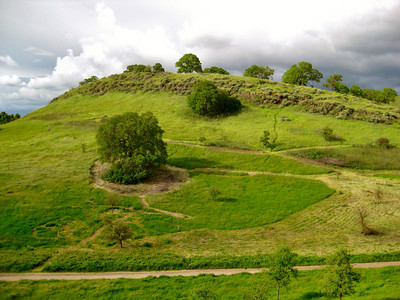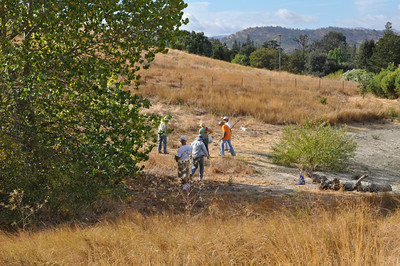Fossil Hill Restoration
Project Background

South Slope of Fossil Hill at the Sutherland Entrance to Shell Ridge
Our Efforts in the Current Season
The initial success of this weed eradication project has opened up an opportunity for restoration efforts in the Fossil Hill area. In the current season (2012-2013) we plan to plant several hundred plugs of the native perennial grasses Stipa pulchra and Bromus carinatus.Our initial goal is modest and we have begun by planting a mixture of native perennial grasses and forbs and bulbs within a 1/4 acre of worked area. We are still in the process of analyzing what this area is best suited for and what native plants may have grown here before the weed infestation. In the 2012-2013 season, we planted Griindelia camporum, a woody perennial that is mentioned by John Muir as being a member of the great fields of spring wildflowers he encountered in the Central Valley (it also occurs in or close to our Coastal Sage Scrub communities). California Poppies, which need no introduction, have also been included, as well as Holocarpha heermannii (Tarweed), and Tritelia laxa (Ithurel's Spear), a classic, early spring bulb of California.
Future Plans
Our tasks for the remainder of the 2013 focus on the prevention of any plants of Brassica nigra (as well as other exotic grasses, etc…) going to seed during this growing season in our newly planted areas. We will also work on eliminating Brassica nigra on several other monocultural stands in the Fossil Hill/Sutherland Entrance area as well as controlling individual outliers to eliminate any source of reinfection of our cleared areas. We have begun, as of early February 2013, to mow and weed whack identified areas, and are looking forward to a Spring of weeding and watching our new plants grow and flower.Indian Valley Pond Restoration
Indian Valley Pond
Project Background
Indian Valley Pond is a natural stopping place for people and pets in Shell Ridge. Located just below Indian Valley Elementary, the pond is home to Pacific tree frogs, western toads, and a scattering of native plants. Restoration of the pond began in 2010 in an effort to rebuild the populations of native plants in and around the pond, which will be a benefit for native wildlife.The difficulty of planting in the pond itself has been the large fluctuations in the water level. These fluctuations are a result of erratic rainfall and the ponds origin as a stock pond when cattle were allowed to graze in Shell Ridge. The pond was likely placed in a naturally wet depression that would have been home to many wet-adapted native plants. These plants were lost when the depression was deepened and dammed for the stockpond, but many of these same plants can be planted within and adjacent to the pond.
Our Efforts in the Current Season
Since 2011, the primary planting area has been on the south side of the pond near its center. So far, hundreds of native grass plugs including needlegrass (Stipa pulchra), blue wildrye (Elymus glaucus), one-sided blue grass (Poa secunda), and junegrass (Koeleria macrantha) have been planted in this area. The goal for this area is dense cover of native bunchgrasses as a base with a mix of native forbs. We have begun to add native rushes (Juncus occidentalis) and wildflowers including checkerbloom (Sidalcea malviflora) into the mix over the last year and expanded into other zones around the pond that have only been lightly planted so far.Future Plans
Future plans include expanding the restoration areas and planting more grasses, a variety of wildflowers and some native shrubs. We also hope to plant some riparian trees to provide more structure for the pond itself. We will also continue to remove invasive weedy species such as mustards (Hirschfeldia and Brassica) and dock (Rumex crispus and pulcher) that occur in relatively dense patches around the pond. We are hoping to eventually be able to fix erosion around the pond especially from two gullies on the slope between the school and the pond.Community Service Day

Volunteers at Bayberry Pond during Community Service Day 2012

6th graders from Seven Hill School planting grasses in Heather Farm Park
Educational Programs
The Walnut Creek Open Space Foundation works to promote widespread appreciation of our open space, its scenic beauty, recreational benefits and environmental character in a variety of ways.We sponsor wildflower and birding walks to help people recognize and appreciate the plants and animals found in our open space. We provide information in our newsletters and on our website to describe geology, and many aspects of natural history. We describe walks you can take and list flowering plants to be seen along several routes. We also donate books on the area's natural history to schools and libraries.




 Join
Join Donate
Donate Volunteer
Volunteer Maps
Maps Newsletter
Newsletter Facebook
Facebook
